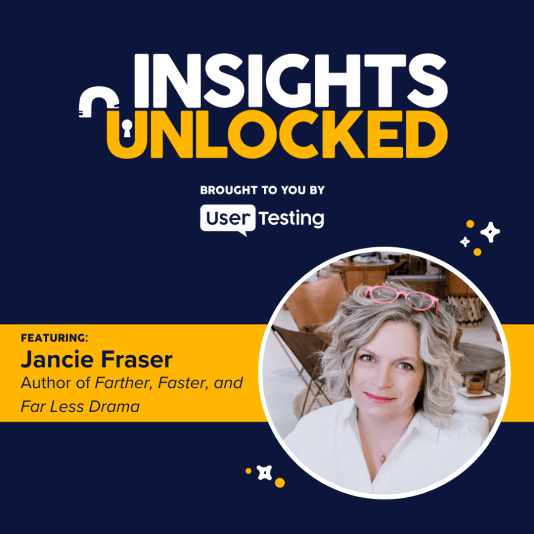Unlocking quicker decisions: Janice Fraser's four leadership motions
Listen to the episode
Now Streaming On




Make faster, more durable decisions for your organization
From the UX and product design front lines to the C-Suite, it can be a challenge to quickly and confidently make the decisions you need to make.
In this Insights Unlocked episode, UserTesting’s CEO Andy MacMillan interviews Janice Fraser about her four leadership motions outlined in her new book, "Farther, Faster, and Far Less Drama."
Fraser says employing the leadership motions—whether individually or in combination with each other—will help you make quicker decisions, achieve goals faster and make complex situations more manageable regardless of your role.
Fraser is a prominent figure in the tech world known for her expertise in UX and innovation. She is a product leader, founder of six companies, an investor, and an advisor to startups and enterprise executives. She also was a founding partner of Adaptive Path, one of the original UX consultancies.
She and her husband and co-author, Jason Fraser, have developed their leadership motions over several decades, helping all kinds of people—including Navy SEALs, startup CEOs, and Fortune 100 executives—make progress in both their professional and personal lives by solving hard problems with grace.
“The four leadership motions are everything we learned over the last 20 years distilled down into what are practical, useful things that any leader could do, in any situation, to go faster, get there farther and with far less drama,” Fraser said.
The Four Leadership Motions:
Janice outlines the four transformative leadership motions from her book:
- Orient Honestly: Understand the complexities of any situation by seeking clarity and truthfulness in the moment.
- Value Outcomes: Prioritize outcomes over rigid plans, activities, or deliverables to achieve goals faster.
- Leverage the Brains: Tap into the expertise of the right people and maximize their contributions for smarter decisions.
- Make Durable Decisions: Eliminate two pernicious kinds of waste to make decisions that propel the team forward.
“Each of the motions can be used independently, in any order. And you could just spin the dial,” Fraser said. “ And it lands on Orient Honestly. And you're like, ‘how could I get more clear and truthful about what's complicated in this moment?’”
To tee up the episode’s conversation, we reached out to technology professionals within UserTesting’s global contributor network to share their thoughts about how decisions are made in their organizations.
And here's what they said:
The Power of Durable Decision-Making
The episode revolves around the topic of making effective decisions with the right stakeholders. Fraser introduces the concept of "durable decision-making," where decisions are good enough to move the team forward and can be supported by everyone involved. She believes that waiting for the perfect decision is counterproductive, as it leads to stagnation and wasted time.
She said we lose time before a decision happens and after a decision happens. We lose it before because of unrealistic standards such as is it the right decision?
“Who knows? There's no way to know whether a decision is right or best,” she said. “That is an unachievable standard.
And then the other way that we lose time before a decision is made is we try to include everybody. We try to aim for consensus.”
“Someone needs to be able to make a decision as a service to the team so that we can move forward,” Fraser said.
MacMillan agreed. “What I don't want to do is value that we got to a decision only to then next week start over again,” he said. “Giving people skills and capabilities and frameworks to think about how to get to durable decisions; that really resonated.”
Trusting the Team and Embracing Healthy Conflict
The conversation emphasizes the significance of trust and respect within the team and how it fosters healthy conflict, enabling the team to make bold decisions. Janice shares her experience from her time at Netscape, where the CEO's approach of "if you see a snake, kill it" taught her to stop second-guessing decisions and embrace the authority to say yes.
“And it's not a consensus” MacMillan said. “We're not going to hold up a decision until everybody agrees. You've had your chance to have your input and then somebody is going to make a decision. That's good enough. That's going to get us to the next phase that we can sort of have the ability to move on.
Inviting Collaboration, Not Managing Stakeholders
The discussion highlights the importance of involving people with the authority to say yes, subject matter experts, and those who have to live with the outcomes in the decision-making process.
Rather than trying to manage stakeholders, Fraser suggests inviting people to co-create decisions, respecting their expertise, and trusting their judgment.
“We need to have that trust and respect for each other laterally so that when we make these decisions that feel a little bit risky to some of us, we're doing it because we respect each other and that's what a functional team really does,” she said.
The foundation needs to be built on trust and respect. “No amount of process will fix incorrect mindsets,” she said. “I love process, but process will not save us. What will save us is a mindset of respect and trust.
If you can't have an empowered team that you trust to make decisions, then you don't have a decision making framework problem. You have a team problem. And if you get the right team in place, then you can work out how to make better decisions.
Listeners interested in learning more about Janice Fraser or her book can visit her website, janicefraser.com.


